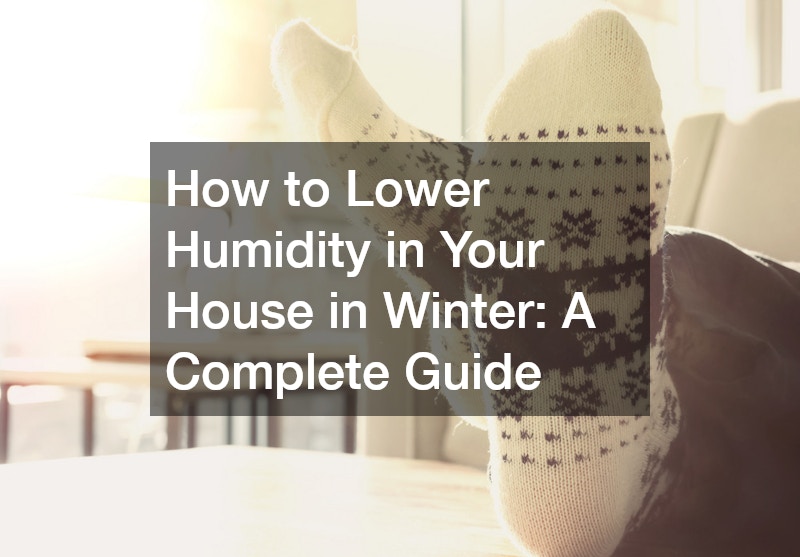Many people think humidity is only an issue in the summer. However, indoor humidity can become a problem even in colder months. Excess moisture in your home during winter can lead to condensation on windows, mold growth, and discomfort. If you’re wondering how to lower the humidity in your house during winter, this guide will walk you through several effective methods to keep your indoor environment comfortable and healthy.
Why Is Indoor Humidity High in Winter?
Before diving into solutions, it’s important to understand why indoor humidity levels might rise in the winter. Typically, cold outdoor air holds less moisture, but indoor activities like cooking, showering, and running heating systems can cause moisture to accumulate inside. Additionally, modern homes are built to be energy efficient, with tight seals that prevent air from escaping. While this reduces heat loss, it can also trap moisture indoors.
Why Is High Humidity a Problem in Winter?
Excess humidity in your home during the winter can lead to several problems:
- Condensation: When warm, moist air comes into contact with cold surfaces (like windows), condensation forms. Over time, this can damage window frames and sills.
- Mold Growth: High humidity levels create the perfect environment for mold and mildew to grow, which can cause health issues and damage your home.
- Poor Air Quality: Excess moisture can make your indoor environment feel stuffy and uncomfortable.
- Structural Damage: Prolonged high humidity can damage your home’s woodwork, furniture, and insulation.
Ideal Indoor Humidity Levels in Winter
Winter’s ideal indoor humidity level is typically between 30% and 50%. If your home’s humidity rises above 50%, you may notice issues like condensation and dampness. Keeping indoor humidity in check can prevent these problems and ensure a healthier living environment.
How to Measure Humidity in Your Home
Before you start tackling excess humidity, you’ll need to know your indoor levels. The easiest way to measure humidity is with a hygrometer. This simple device displays the moisture percentage in the air, helping you monitor and adjust your indoor humidity as needed.
1. Use a Dehumidifier
A dehumidifier is one of the most effective ways to lower humidity in your home. Dehumidifiers are designed to pull excess moisture from the air, making your indoor environment drier and more comfortable.
How to Use a Dehumidifier:
- Place It in High-Moisture Areas: Use the dehumidifier in rooms where moisture accumulates, such as the kitchen, bathroom, or basement.
- Adjust the Settings: Set the dehumidifier to your desired humidity level (typically 30% to 50%).
- Empty the Water Tank Regularly: Most dehumidifiers collect water in a tank that needs to be emptied regularly.
Dehumidifiers come in various sizes, so choose one that fits your home’s room size and humidity levels.
2. Ventilate Your Home Properly

Good ventilation is key to controlling indoor humidity levels. In winter, it’s easy to keep windows and doors sealed tightly to conserve heat, but this can trap moisture inside. Here are some tips to improve ventilation:
Use Exhaust Fans
- In the Kitchen: Cooking generates a lot of steam, which adds moisture to the air. Always use your kitchen’s exhaust fan to vent the steam outside while cooking.
- In the Bathroom: Hot showers create a humid environment in your bathroom. Running the bathroom fan during and after your shower will help to clear out excess moisture.
Open Windows for Short Periods
Even in cold weather, opening windows for just 5-10 minutes can significantly improve ventilation and reduce indoor humidity. This allows moist air to escape and fresh, dry air to enter.
Crack Windows in High-Moisture Areas
Cracking a window in rooms with higher humidity levels, like kitchens or bathrooms, can help moisture escape naturally.
3. Avoid Over-Watering Houseplants
Houseplants can contribute to indoor humidity levels through transpiration, where plants release moisture into the air. If you have a lot of plants in your home, consider reducing their number or moving them to a single room. Additionally, avoid overwatering them, as excess water in the soil can increase humidity.
4. Dry Laundry Outside or Use a Ventilated Area
Hanging laundry indoors to dry can introduce a significant amount of moisture into the air. If possible, dry your clothes outside, even in the winter, or use a well-ventilated room with a dehumidifier running. Alternatively, you can use a vented dryer to expel the moist air outside.
5. Control Moisture from Showers and Cooking
Hot showers and boiling pots of water are common sources of excess moisture in your home. Here’s how to reduce the impact:
Take Shorter, Cooler Showers
- Taking shorter showers and using cooler water will reduce the steam produced, lowering humidity levels in your bathroom.
Cover Pots and Pans While Cooking
- Covering pots while cooking will trap the steam and prevent it from escaping into the air. Additionally, lids can help food cook faster and reduce the need for extended cooking times.
6. Use a Space Heater
Space heaters can help reduce humidity by heating the air, which can help it hold more moisture, preventing condensation. Additionally, running a heater in damp areas of your home can dry out excess moisture. However, don’t rely solely on space heaters if your home’s humidity is too high—they’re just one part of the solution.
7. Keep Gutters and Downspouts Clear
Moisture from outside can sometimes seep into your home, contributing to higher humidity levels. If your home’s foundation or walls are exposed to pooling water or poor drainage, it can result in damp conditions indoors.
Clean Out Your Gutters
Regularly clearing leaves and debris from your gutters ensures rainwater flows away from your home’s foundation.
Extend Downspouts
To direct water away from your walls and basement, make sure your downspouts extend at least 3 feet away from the foundation of your home.
8. Seal Gaps and Cracks
Moisture can enter your home through gaps and cracks in windows, doors, and walls. Sealing these areas will help reduce drafts and prevent moisture from creeping in.
Use Caulk and Weatherstripping
Apply caulk around windows and doors and install weatherstripping to keep cold, moist air from entering your home. This will reduce humidity and improve your home’s energy efficiency.
9. Use Moisture Absorbers
Moisture absorbers, like desiccant packs or products such as DampRid, can be placed in closets, basements, or small spaces where humidity tends to be higher. These products absorb moisture from the air and help to lower humidity levels in localized areas.
10. Improve Insulation
Inadequate insulation can lead to condensation and moisture buildup, particularly around windows, walls, and roofs. Improving insulation helps to regulate your home’s temperature and reduce condensation on cold surfaces.
Upgrade Window Insulation
Install storm windows or use plastic window insulation kits to reduce condensation in winter.
Insulate Pipes and Ducts
Insulate your home’s pipes and ducts to prevent condensation, especially if they run through unheated spaces like basements or crawl spaces.
11. Monitor Indoor Activities
Daily activities such as showering, cooking, and laundry contribute to indoor humidity. To reduce moisture in the air:
- Use lids on pots while cooking
- Run fans during and after showers
- Avoid drying clothes indoors
By being mindful of these activities, you can prevent the buildup of excess moisture in your home.
Conclusion
Maintaining a comfortable humidity level in your home during winter is crucial for your comfort and your home’s health. Excess indoor humidity can lead to mold growth, condensation, and poor air quality, so it’s important to take steps to manage it. Using a dehumidifier, improving ventilation, controlling moisture from daily activities, and sealing up gaps and cracks are all effective ways to lower humidity in your house during winter. By following these tips, you’ll enjoy a more comfortable living environment and protect your home from potential moisture damage.


